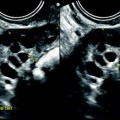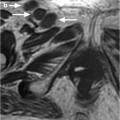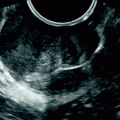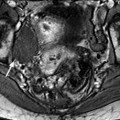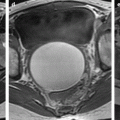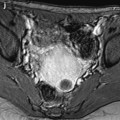Jean Noel Buy1 and Michel Ghossain2
(1)
Service Radiologie, Hopital Hotel-Dieu, Paris, France
(2)
Department of Radiology, Hotel Dieu de France, Beirut, Lebanon
34.1 Definitions
34.2.4 Auxiliary Genital Glands
34.3 Anatomy [, ]
34.3.1 Labial Formations (Fig. )
34.3.2 Vestibule (Figs. and )
34.3.3 Erectile Apparatus
34.3.4 The Glands
34.3.5 Vascularization and Nerves
34.4 Histology
34.5 Normal MR Imaging
Abstract
Two anatomical compartments are described (Table 34.1):
34.1 Definitions
Pelvic diaphragm: Levator ani and ischiococcygeus (also called coccygeus) form the pelvic diaphragm and delineate the lower limit of the true pelvis.
Perineum
(a)
Limits
The deep limit: the inferior surface of the pelvic diaphragm
The superficial limit: the skin which is continuous with that over the medial aspect of the thighs and the lower abdominal wall.
(b)
Comprises
Anal triangle
Urogenital triangle
Urogenital triangle comprises from deep to the superficial:
Deep perineal space (between deeply the endopelvic fascia of the pelvic floor and superficially the perineal membrane)
Superficial perineal space (between deeply the perineal membrane and superficially the superficial perineal fascia)
Vulva or pudendum or external female genitalia compartment (between the superficial fascia and the skin)
Anatomical definition of vulva or pudendum or external female genitalia comprises the following anatomical structures:
Labial formations: Mons pubis, pubis, labia major, labia minora
Erectile organs (clitoris and bulbs of the vestibule)
Glands and their ducts (Bartholin’s and Skene’s glands)
Vestibule containing vaginal orifice (introitus), hymen vaginae
External urethral orifice also called external urethral meatus.
Although most of these anatomical structures belong to the most superficial anatomical compartment of the anterior urogenital triangle (female external genitalia compartment), in fact some of them are located or arise in the superficial perineal space (Table 34.1) (Figs. 34.1 and 34.2)
Table 34.1
Components of the vulva
Anatomical Compartment
Anatomical structures
Vulva
Superficial perineal space
1. Labial formations
Mons pubis
Mons pubis
Labia majora
Labia majora
Labia minora
Labia minora
2. Erectile organs
Clitoris
Corpora cavernosa
Corpora cavernosa
Corpus clitoridis
Corpus clitoridis (1/2 anterior)
Corpus clitoridis (1/2 posterior)
Glans
Glans
Bulbs of the vestibule
Bulbs of the vestibule (anterior part: joins to the posterior part of corpus clitoridis)
Bulbs of the vestibule (posterior and middle part)
3. Glands
Greater vestibular glands
Greater vestibular glands (anterior part)
Greater vestibular glands (posterior and middlepart)
Ducts
Ducts
Skene’s glands
Skene’s glands
Skene’s glands
Skene’s ducts
Skene’s ducts
Skene’s ducts
4. Vestibule (between labia minora)
Urethra
Urethral meatus (in vestibule)
Urethra (part of perineal portion)
Vagina
Vaginal orifice (in vestibule)
Vagina (part of perineal portion)
Hymen
Vulva or pudendum or female external genitalia compartment is limited by:
Deeply
The superficial perineal fascia also called Colles’ fascia which is attached to:
Posteriorly, the fascia over the superficial transverse perinei and the posterior limit of the perineal membrane.
Laterally, the margins of the ischiopubic rami and the ischial tuberosities; from here it runs more superficially to the skin of the urogenital triangle, lining the external genitalia, where it ends in the labia majora.
Superficially
The skin.
Superficial perineal space
(a)
Is limited by
Deeply
The perineal membrane, which is triangular and is attached
Laterally to the periosteum of the ischiopubic rami
The posterior border is fused with the deep part of the perineal body and is continuous with the fascia over the deep transverse perinei. The upper sheet is continuous posteriorly with the lower part of the rectovaginal septum
Anteriorly at the apex fascia over transverse perinei and the perineal membrane join to form very tight aponeurotic fibres, the transverse ligament of Henlé also called the pubourethral ligament. Its apex is attached to the arcuate ligament of the pubis
Superficially
The superficial perineal fascia also called Colles’ fascia.
(b)
It contains
Superficial transverse perinei (mainly posteriorly)
Bulbospongiosus (medially)
Attaches to the perineal body
On each side is separate
Covers the superficial part of the vestibular bulbs and greater vestibular glands; the vestibular bulbs run anteriorly on each side of the vagina to attach to the corpora cavernosa clitoridis
Ischiocavernosus (laterally)
Attaches on the ischiopubic ramus on both sides of the corpus clitoridis
Covers the corpora cavernosa of the clitoridis, ends in an aponeurosis attached to the sides and under surface of the of the crus; anteriorly corpora cavernosa of the clitoridis join to form the corpus clitoridis (hidden part)
34.2 Embryology [1] (See Fig. 1.4)
34.2.1 Common Development in Female and Male
Up to the seventh week, the external genitalia are similar in both sexes. Distinguishing sexual characteristics begin to appear during the ninth week, but the external genitalia are not fully differentiated until the 12th week.
In the fourth week, proliferating mesenchyme produces a genital tubercle at the cranial end of the cloacal membrane.
Labioscrotal swellings and urogenital folds soon develop on each side of the cloacal membrane. The genital tubercle elongates to form a primordial phallus.
When the urorectal septum fuses with the cloacal membrane at the end of the sixth week, it divides the cloacal membrane in a dorsal anal membrane and a ventral urogenital membrane.
The urogenital membrane lies in the floor of a median cleft, the urethral groove, which is bound by the urogenital folds. The anal and urogenital membranes rupture a week later, forming the anus and urogenital orifices. The urethra and the vagina open in a common cavity, the vestibule.
34.2.2 Development of Male External Genitalia
Masculinization of the indifferent external genitalia is induced by testosterone produced by the interstitial cells of the fetal testes.
As the phallus enlarges and elongates to become the penis, the urethral folds form the lateral walls of the urethral groove on the ventral surface of the penis.
34.2.3 Development of Female External Genitalia
(a)




The primordial phallus gradually becomes the clitoris.
Stay updated, free articles. Join our Telegram channel

Full access? Get Clinical Tree



